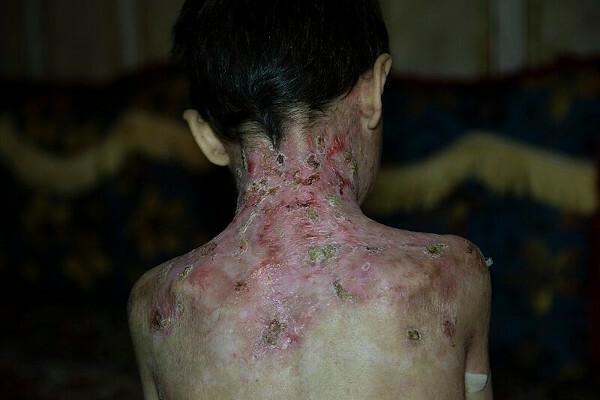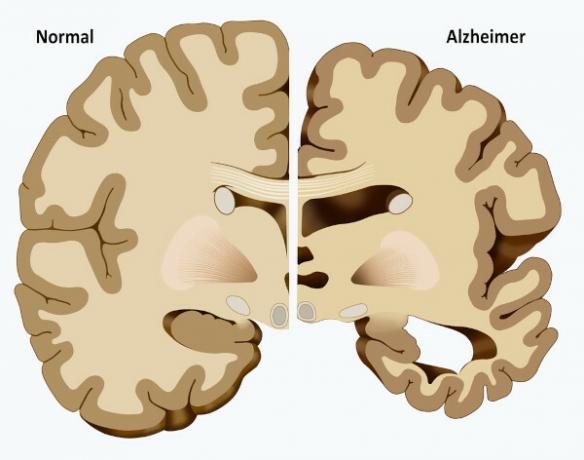epidermolysis bullosa It is a rare genetic disease that compromises the skin, causing it to become very sensitive. In this disease, the formation of lesions and blisters is observed spontaneously or after minimal mechanical trauma.
These lesions can occur in a more localized way or affect the body in a generalized way, and may also affect the mucous membranes. The disease affects both sexes and manifests itself in childhood. It is not a communicable disease and, unfortunately, so far, there is no cure. Treatment includes drug and non-drug measures.
Read too: Psoriasis — a skin disease characterized by causing lesions on various parts of the human body
Topics of this article
- 1 - Summary of epidermolysis bullosa
- 2 - What is epidermolysis bullosa?
- 3 - Symptoms of epidermolysis bullosa
- 4 - Complications of epidermolysis bullosa
- 5 - Types of epidermolysis bullosa
- 6 - Diagnosis of epidermolysis bullosa
- 7 - Treatment of epidermolysis bullosa
- 8 - Why are children with epidermolysis bullosa called “butterfly children”?
Summary about epidermolysis bullosa
Epidermolysis bullosa is a rare disease that causes the development of bullous lesions in the skin.
The region frequently affected is the hand, which can present constant scars that promote deformities.
According to the Ministry of Health, the four types of epidermolysis bullosa are: simple, junctional, dystrophic and Kindler syndrome.
Diagnosis is usually made by skin biopsy and direct immunofluorescence.
Treatment includes the adoption of drug and non-drug measures for the prevention and treatment of bullous lesions.
The expression “butterfly children” is used to refer to children with epidermolysis bullosa, due to the fact that their skin is as fragile as a butterfly's wing.
What is epidermolysis bullosa?
epidermolysis bullosa it is a rare genetic disease that affects the skin. It occurs as a result of mutations present in the genes responsible for forming proteins that ensure the cohesion of the skin layers, compromising its resistance when subjected to mechanical stress. The disease characterized by the formation of bubbles, which arise due to minimal friction or trauma. Blisters can appear in a localized or generalized way, affecting different parts of the body.
epidermolysis bullosa It is an incurable, non-transmissible disease that can affect both men and women and affect people of all ethnicities.. The first signs of the disease can already be noticed soon after birth. According to the Ministry of Health, it is estimated that 500,000 people worldwide have the disease, and in Brazil, according to the Debra Association, there are 802 people diagnosed with epidermolysis bullosa.
Do not stop now... There's more after the publicity ;)
Symptoms of Epidermolysis Bullosa
epidermolysis bullosa characterized by the appearance of bullous lesions on the skin, which vary in extent and severity. Lesions can arise spontaneously or in response to trauma, even small ones, and can affect different parts of the body.
The typical blisters of epidermolysis bullosa cause erosions, which heal slowly. The hands are particularly affected in the disease., leading to the formation of several repetition scars, which can culminate in the “cocooning” of the fingers (deformity in the shape of a “boxing glove”). can also happen muscle contractures, dislocations and bone destruction.
Patients with epidermolysis bullosa may have malformed nails. Furthermore, Teeth can also be affected., often malformed and with frequent caries. When the disease affects the mucous membranes, it can cause difficulties in eating, speaking and corneal changes.
Complications of epidermolysis bullosa
The main types of complications observed in case of epidermolysis bullosa are:
bacterial superinfection (superimposition of another infection) followed by sepsis, the main cause of death during the neonatal period;
deforming scarring;
appearance of neoplasms aggressive skin lesions, main cause of mortality in adolescents.1|
Types of Epidermolysis Bullosa
According to the Ministry of Health, there are more than 30 types of epidermolysis bullosa, but four stand out as the main ones:
Epidermolysis Bullosa Simplex (EBS): the formation of a superficial blister is observed, which is generally not responsible for leaving scars. It usually affects the feet and hands, and is seen to worsen in hot, humid periods. The appearance of blisters decreases with age.
Junctional Epidermolysis Bullosa (EBJ): the bubbles formed are deeper and occupy most of the surface of the individual's body. In general, death occurs before the first year of life. However, when the disease is controlled, it tends to improve with age.
Dystrophic Epidermolysis Bullosa (EBD): blisters form between the dermis and epidermis, promoting scarring and even, in some situations, loss of limb function. It stands out as the form that promotes the greatest appearance of sequelae.
Kindler Syndrome: can be defined as a mixture of the previous forms. Promotes the appearance of blisters, sun sensitivity, skin atrophy, intestinal inflammation and mucous stenosis.
Diagnosis of epidermolysis bullosa
Epidermolysis bullosa is diagnosed based on the analysis of the symptoms presented by the individual in association with the performance of tests. In general, the diagnosis is made through skin biopsy and direct immunofluorescence.
See too:Lupus — an autoimmune inflammatory disease that has no known cause
Treatment of epidermolysis bullosa
epidermolysis bullosa it is a disease without cure, but presents a treatment that aims to avoid complications. The treatment must involve a multidisciplinary team, since the disease can affect several organs and systems of our body. Among the professionals involved, we can mention pediatricians, dermatologists, ophthalmologists, dentists, neurologists, psychologists and others.
The treatment includes the adoption of drug and non-drug measures in the prevention and at the treatment of bullous lesions. Treatment includes measures to control pain, itching, heat, and bacterial load. In the case of injury prevention, it is important to highlight that the individual can go to school and have leisure activities, as long as they are supervised and adapted to each situation. As the disease has no cure, the most important thing is to guide yourself to avoid the appearance of blisters.
Some complications may require surgical treatment, as in the case of retractions and contractures. More often, surgical indications are aimed at treating deformities in the hands, since these structures are very important for the development of daily activities.
Why are children with epidermolysis bullosa called “butterfly children”?

“Butterfly children” is an expression used to refer to children with epidermolysis bullosa, due to the fragility of the skin of the individual with the disease. The reference is made considering that these children's skin is very delicate, like the wings of butterflies.
Note
|1| COUTO, C. S.; GOUVEIA, C.; MIGUENS, C.; MARQUES, R. Practical guide in the approach to the patient with Epidermolysis Bullosa. Portuguese Association of Epidermolysis Bullosa - Portuguese Society of Dermatology and Venereology, c2018. Available in: https://debra.med.up.pt/wp-content/uploads/sites/19/2018/06/Epiderm%C3%B3lise-Bolhosa-guia-pratico_2017.pdf.
Sources
COUTO, C. S.; GOUVEIA, C.; MIGUENS, C.; MARQUES, R. Practical guide in the approach to the patient with Epidermolysis Bullosa. Portuguese Association of Epidermolysis Bullosa - Portuguese Society of Dermatology and Venereology, c2018. Available in: https://debra.med.up.pt/wp-content/uploads/sites/19/2018/06/Epiderm%C3%B3lise-Bolhosa-guia-pratico_2017.pdf.
FALOPPA, F.; CAPORRINO, F. A.; SANTOS, J. B. G.; ALBERTONI, W. M. Treatment of syndactyly in epidermolysis bullosa. Brazilian Journal of Orthopedics, v. 31, no. 3, 1996. Available in: https://www.rbo.org.br/detalhes/609/pt-BR/tratamento-da-sindactilia-na-epidermolise-bolhosa.
MINISTRY OF HEALTH. Epidermolysis Bullosa. Ministry of Health, [n.d.]. Available in: https://www.gov.br/saude/pt-br/assuntos/saude-de-a-a-z/e/epidermolise-bolhosa.
MINISTRY OF HEALTH. Recommendation report: Clinical Protocols and Therapeutic Guidelines — Brazilian Guidelines for Epidermolysis Bullosa. Ministry of Health, 2021. Available in: https://www.gov.br/conitec/pt-br/midias/consultas/relatorios/2021/20210920_ddt_eb_cp79.pdf.
PAULA, E. j. L.; MATTAR JUNIOR, R.; ARIMA, M.; AZZE, R. j. Hand reconstruction in epidermolysis bullosa. Revthis brasrow of Ortopit is day, v. 37, no. 6, 2002. Available: https://www.rbo.org.br/detalhes/400/pt-BR/reconstrucao-da-mao-na-epidermolise-bolhosa-.
By Vanessa Sardinha dos Santos
Biology teacher
Learn about genes, specific sequences of DNA found in our chromosomes that make up the unit of heredity.
Occasional changes that occur in genes.
Do you know what neoplasia is? Click here to find out what it is and understand the difference between so-called benign and malignant neoplasms.
Click here and see what mutation is and how it occurs in a living organism.
Know which are the layers that form the skin.



